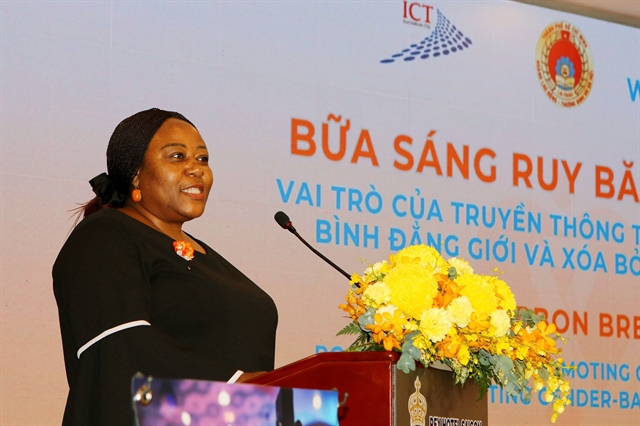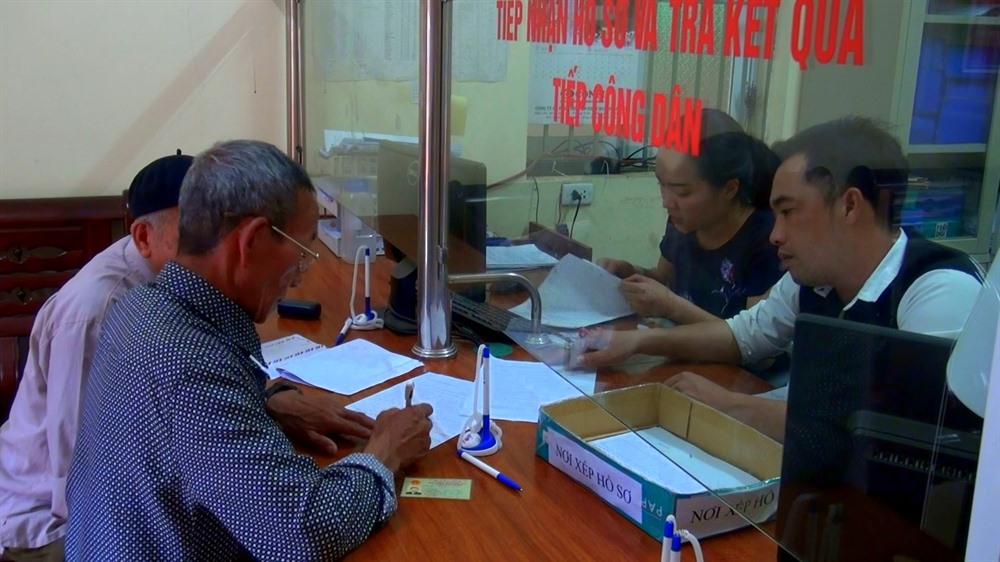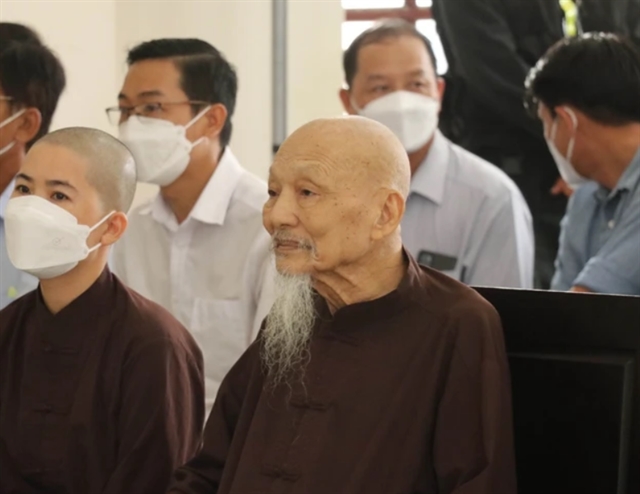 Opinion
Opinion

Nguyễn Hoàng Phương, Deputy Director of the Technology Centre of Việt Nam Social Security (VSS) talks to Việt Nam News on the strides the centre has made in technology adoption to achieve efficiency and better delivery of public services.
 |
| An insurance official in the northern mountainous province of Sơn La instructs elder citizens to fill out the forms. — VNA/VNS Photo |
Nguyễn Hoàng Phương, Deputy Director of the Technology Centre of Việt Nam Social Security (VSS) talks to Việt Nam News on the strides the centre has made in technology adoption to achieve efficiency and better delivery of public services.
In 2017 and 2018, Việt Nam Social Security (VSS) topped various Government technology rankings, including the lists for e-portal and human resources capacity and the technology readiness (ICT Index). Could you tell us more about VSS’s achievements in this regard and how they came to be?
Information technology (IT) application, administrative reforms and raising the capacity of our staff have been at the forefront of the VSS agenda in recent years as we move into the Industry 4.0 era.
Technology has been deeply integrated into our operational document management system, meaning all working documents, directives and professional guidelines have been digitalised and are used across all local branches.
All insurance accounting and transaction management works are now conducted on uniform software that pools data into a single management system and database at the central level. All insurance beneficiaries’ documents have also been digitalised, in contrast to previous paper-based management methods. In the near future, all Vietnamese citizens who have joined the Government’s insurance scheme will have an online profile, accessible with a social security number, that contains all relevant information and archived documents. The only difficulty now is to finish the verification of all existing documents.
All 23 of our public services can now be accessed online, meaning that people can look up information, fill out forms and carry out transactions entirely online. In 2018, 44 million documents were processed online.
In co-ordination with the health ministry, all 12,600 hospitals and medical facilities that cater to participants in the Government’s insurance scheme are connected to the health insurance assessment portal. This prevents fraud while allowing for better monitoring of healthcare service delivery. The application of technology has also helped to automatically flag any abnormalities found in insurance documents instead of manually inspecting each document as we used to do.
Our efforts in administrative reforms were also recognised internationally as Việt Nam ranked 86 out of 190 countries and territories in terms of social and health insurance payment on the World Bank’s 2018 Doing Business survey, recording a significant jump of 81 places from 2017.
These achievements were the result of VSS’s strong commitment, robust efforts from the entire sector and a properly designed roadmap to invest in technology.
What are VSS’s priorities for the 2019-2020 period?
First, the Government has approved a project to build a national public administration portal, which is expected to be operational in November this year. This new portal will use social insurance numbers as the main component in every citizen’s profile, which will also include one’s information from tax authorities and banks. This is quite a tall order for us, given the tremendous workload in ensuring the security of all the information and to verify all of our existing data prior to sharing them to the national portal. We also need to work towards making all of our services available on the portal at launch.
Second, in the Government’s Resolution 17 dated March 7 on key tasks and solutions to facilitate e-Government development during the 2019-20 period, VSS is supposed to fully deploy its public services, form better information sharing mechanisms with other ministries and sectors and develop the national social insurance database – a critical part of the shift towards e-Government. In 2019, we will partner with the justice ministry to share birth and death certificates, with provincial and municipal people’s committees to facilitate our services in local public administration centres, with the labour ministry with regards to unemployment insurance, with the health ministry on health insurance information and with the tax authorities and the State Bank of Việt Nam.
Third, we will also be looking to improve IT application at firms. Recently, we have focused on deploying e-payment and improving the internal workings of VSS, and have devoted less energy to ensuring employers’ worker information and databases can be shared with us. Currently, each company uses its own human resources management system and it takes too much time to compile the information required for social insurance. This issue will be fixed as we develop a standard template and tools that firms can refer to while developing their own add-ons that will help save time. For small businesses, we can also provide social insurance management software.
What could stand in the way of obtaining these goals?
There are a number of challenges to implementing these tasks.
The biggest one is a lack of laws and regulations for information sharing between State agencies. VSS will need to create a co-operation mechanism, which will vary from agency to agency and is highly dependent on their willingness. The recent Government-approved plan to craft a decree on management and sharing of digital databases will help to uniformly regulate this activity.
As reforms are taking place quickly, social insurance workers will need to try their hardest to catch up. To assist them, VSS is providing re-training programmes for our workers, re-arranging jobs and outsourcing part of our IT infrastructure management duties.
Another concern is data breaches as technology becomes more pervasive. VSS has co-operated with a number of State agencies and businesses, especially the Ministry of Information and Communications, to ensure information security. Given the sensitivity and value of the social security data we are storing, stringent protection measures to prevent compromise are a priority.
The sudden adoption of new technologies in social insurance can be quite disruptive to elderly people, ethic minority people in remote area and other disadvantaged people. How is VSS tackling this issue?
VSS knows our clients are diverse; all citizens, including elderly people, children and other disadvantaged groups, are eligible for the Government’s health insurance and other social insurance services we provide.
There are two sides to the technology coin. On one hand, it brings convenience and timely services to those people with sufficient IT skills and access to technology, but on the other hand, it widens the gap between the first group and those with limited access to technology.
We are fully aware of this issue and are striving to bridge this gap in our efforts to promote IT adoption. On VSS websites, there is an integrated set of accessibility features like magnifying glasses and text-to-speech functions to serve people with disabilities. With regards to pension payment, aside from collecting via bank accounts with ATM cards, elderly people can still receive their payments through traditional means such as at the local social security office or by using free public postal services. We are constantly looking to improve their efficiency. Elderly beneficiaries can choose to have the post office worker deliver their payment right at their home.
Since late last year, social insurance has become mandatory for all foreign workers in Việt Nam. Technology-wise, how has VSS prepared itself to cater to this newly insured group?
The Vietnamese Government is working to sign more bilateral agreements with other countries to avoid duplicate social security contributions for the same income in two countries.
This requires a certain level of technological readiness so social security information between Việt Nam and other countries can be exchanged easily. It also means we must standardise our service criteria to meet international requirements.
When all five of compulsory social security regimes for foreign workers became operational in 2012 (for now, foreign workers only pay contributions to insurance for sickness, maternity and labour accidents/occupational hazards), we had to make sure all our services were available online and in English. There will of course be more English-speaking receptionists added to our customer service department and call centre to provide support for foreign workers.
We are also developing a mobile app that has an English interface to be debuted later in 2019. Given that most expats in Việt Nam are likely tech-savvy, we are considering the use of more advanced technology to deliver better services to them. — VNS
 |
| Nguyễn Hoàng Phương, Deputy Director of the Technology Centre of Việt Nam Social Security. |









